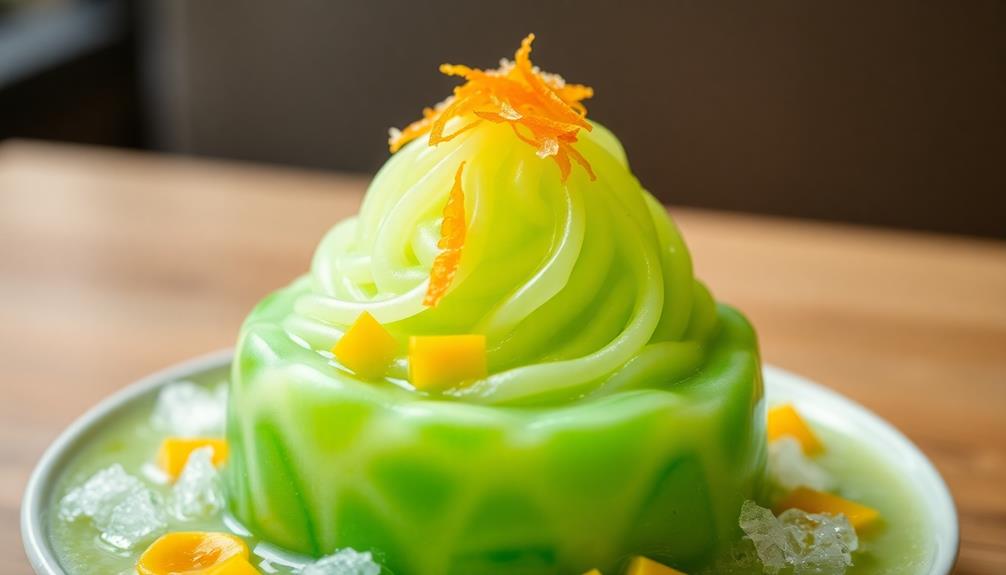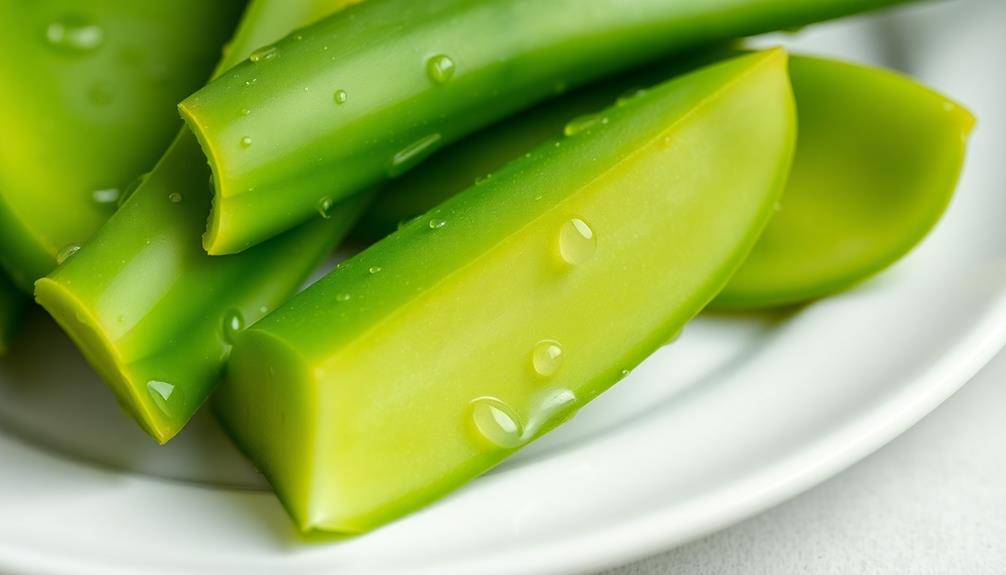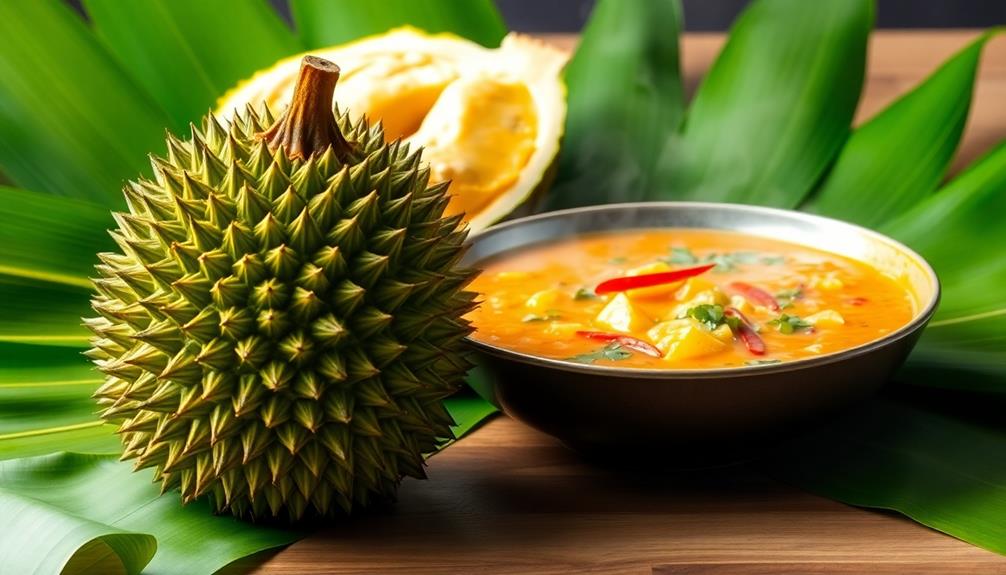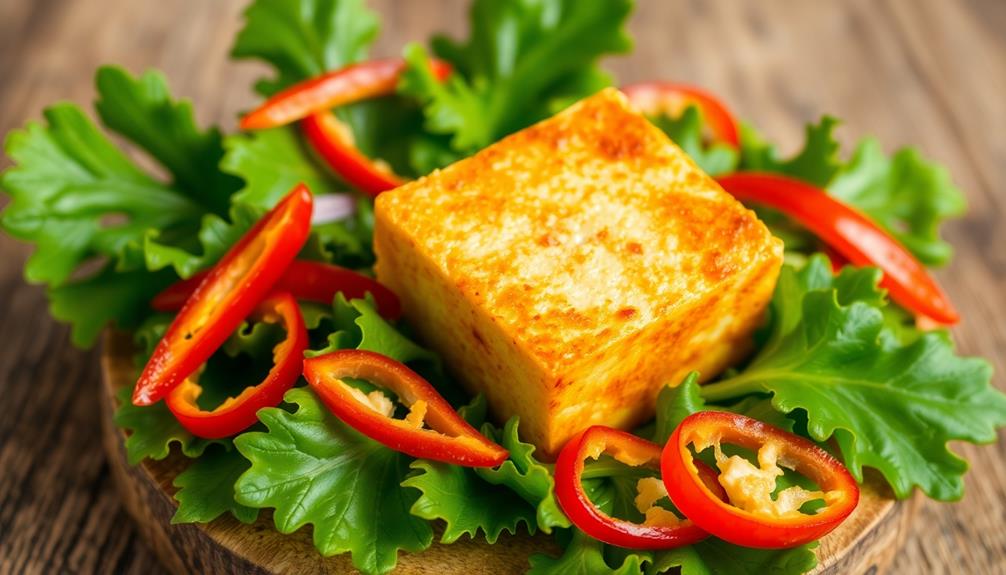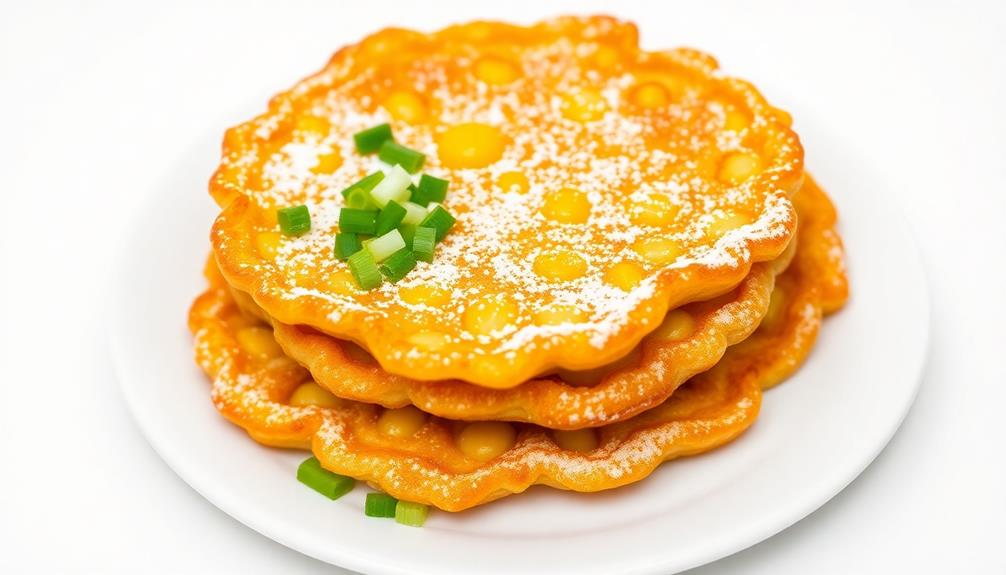Es Cendol is a captivating Southeast Asian dessert that'll delight your taste buds! This vibrant green rice flour jelly is soaked in rich coconut milk and sweetened with palm sugar – it's a harmonious blend of flavors and textures that's been enjoyed for generations. The chewy, jelly-like noodles provide a unique mouthfeel, while the creamy coconut and subtle sweetness create a refreshing, cooling sensation. Es Cendol is a beloved street food across the region, often served during festivals and special occasions. Discover more about the cultural significance and delightful history of this enchanting dessert.
Key Takeaways
- Es Cendol is a traditional Southeast Asian dessert made with green rice flour jelly, popular in countries like Indonesia, Malaysia, Singapore, Brunei, and the Philippines.
- The unique texture and flavor of Es Cendol comes from the combination of chewy green noodles, creamy coconut milk, and sweet palm sugar syrup.
- The history of Cendol traces it back to colonial Southeast Asia, where it started as a popular street food and has since evolved to showcase the region's culinary diversity.
- The key ingredients for making Es Cendol include green rice flour, all-purpose flour, coconut milk, palm sugar, and pandan leaves, along with optional toppings like red beans or corn.
- Es Cendol is culturally significant in Southeast Asia, often served during festivals and special occasions, and its global popularity highlights its appeal as a unique and refreshing dessert.
History
Cendol's origins can be traced back to colonial Southeast Asia, where it emerged as a beloved street food. This delightful treat, made with pandan-flavored green rice flour jelly noodles, coconut milk, and gula melaka (palm sugar), quickly became a refreshing favorite among locals and travelers alike.
Over time, the recipe evolved, with variations appearing across the region. In Malaysia, cendol is often served in a tall glass, layered with shaved ice, coconut milk, and the distinctive green jelly strands.
In Indonesia, it may be combined with avocado, jackfruit, or even durian for a unique twist.
As the popularity of cendol spread, it became a cherished part of the culinary heritage in countries like Singapore, Brunei, and the Philippines.
Today, this vibrant and flavorful dessert continues to delight and inspire sweet-lovers around the world, showcasing the rich diversity of Southeast Asian cuisine.
Recipe
Cendol is a beloved Southeast Asian dessert that has delighted taste buds for generations. Originating from Indonesia, this vibrant and refreshing treat has since spread its delightful influence across the region, captivating the hearts and palates of dessert enthusiasts worldwide.
At its core, cendol is a harmonious blend of textures and flavors, featuring chewy green noodles, creamy coconut milk, and a sweet, aromatic syrup. The dish's distinct green hue comes from the use of pandan leaves, which impart a captivating fragrance and a touch of natural sweetness.
Ingredients:
- 1 cup of green rice flour
- 1/2 cup of all-purpose flour
- 1 teaspoon of salt
- 1 cup of water
- 1/2 cup of brown sugar
- 1 can (400ml) of coconut milk
- 1/2 cup of palm sugar syrup
- 1/2 teaspoon of pandan extract
- Ice cubes
Cooking Instructions:
In a large bowl, combine the green rice flour, all-purpose flour, and salt. Gradually add water, stirring continuously, until a smooth, pliable dough forms.
Using a hand-cranked cendol maker or a potato ricer, extrude the dough into boiling water, creating the distinctive green noodles. Cook the noodles for about 5 minutes, or until they float to the surface. Drain and rinse the noodles under cold water.
Extra Tips:
For an authentic touch, consider adding a few drops of pandan extract to the coconut milk mixture, which will enhance the fragrance and flavor of the dish.
Additionally, you can experiment with different toppings, such as sweetened red beans, jackfruit, or even a drizzle of evaporated milk, to create your own unique variation of this delightful dessert.
Cooking Steps
Let's start by combining the coconut milk and pandan leaves.
Next, you'll add the green rice flour and give it a good stir.
Now, it's time to strain the coconut milk mixture to get a silky smooth texture.
Grab those molds and shape the mixture – then pop it in the fridge to set.
Yum, your homemade cendol is almost ready!
Step 1. Combine Coconut Milk and Pandan Leaves
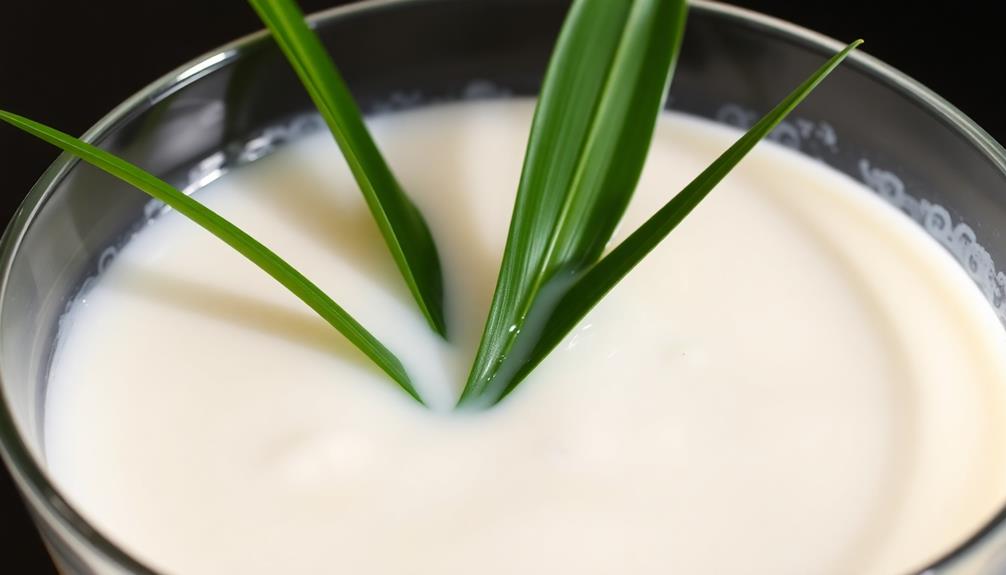
To make the cendol's coconut milk base, you'll want to combine the coconut milk and pandan leaves in a saucepan. The pandan leaves will infuse the coconut milk with their distinctive aroma and flavor.
You'll need to simmer this mixture for about 10 minutes, allowing the flavors to meld together. Be sure to stir the pan occasionally to prevent the coconut milk from scorching.
Once the time is up, you can remove the pan from the heat and let the mixture cool slightly. Then, you'll strain the coconut milk through a fine-mesh sieve to remove the pandan leaves.
This step ensures the cendol base will have a smooth, creamy texture. With the coconut milk base ready, you can move on to the next step of preparing the cendol noodles.
The combination of the fragrant, rich coconut milk and the chewy cendol will create a truly delightful and authentic es cendol dessert.
Step 2. Add Green Rice Flour
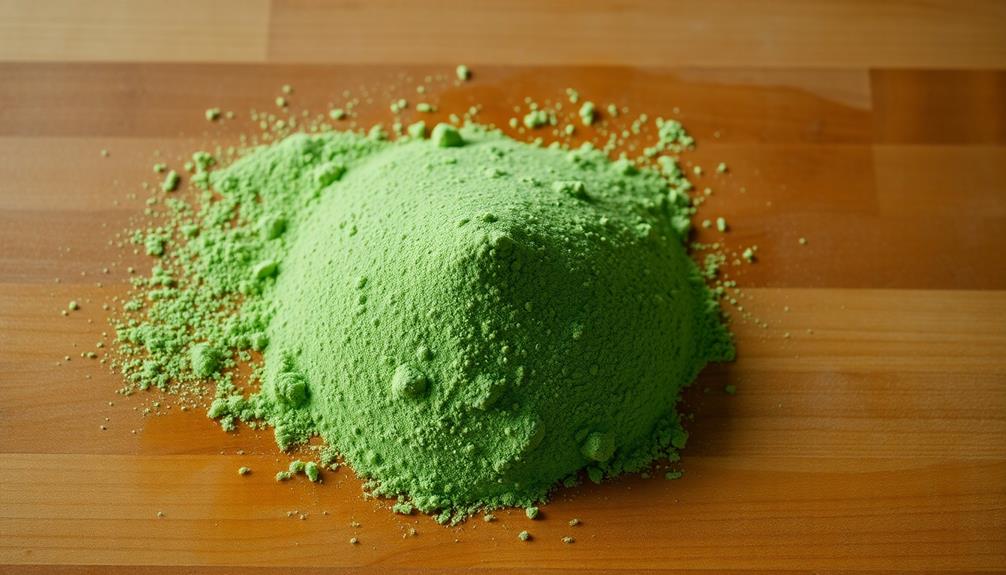
The next step is to add the green rice flour to the strained coconut milk. This crucial ingredient will create the signature green jelly-like noodles that make cendol such a unique and delightful dessert.
Slowly pour in the rice flour, whisking constantly to prevent lumps from forming. Keep stirring until the mixture thickens to a smooth, pudding-like consistency. Don't be afraid to adjust the amount of rice flour – you want a thick, but pourable texture.
Once you've achieved the perfect consistency, it's time to scoop the green cendol noodles into individual serving bowls. Be gentle, as the texture is quite delicate.
Top each portion with the reserved coconut milk, then add a sprinkling of palm sugar syrup. The contrasting flavors and textures of the cool, slippery cendol noodles, creamy coconut milk, and sweet palm sugar create an irresistible harmony in every bite.
Get ready for a true taste of Southeast Asian delight!
Step 3. Strain the Coconut Milk Mixture
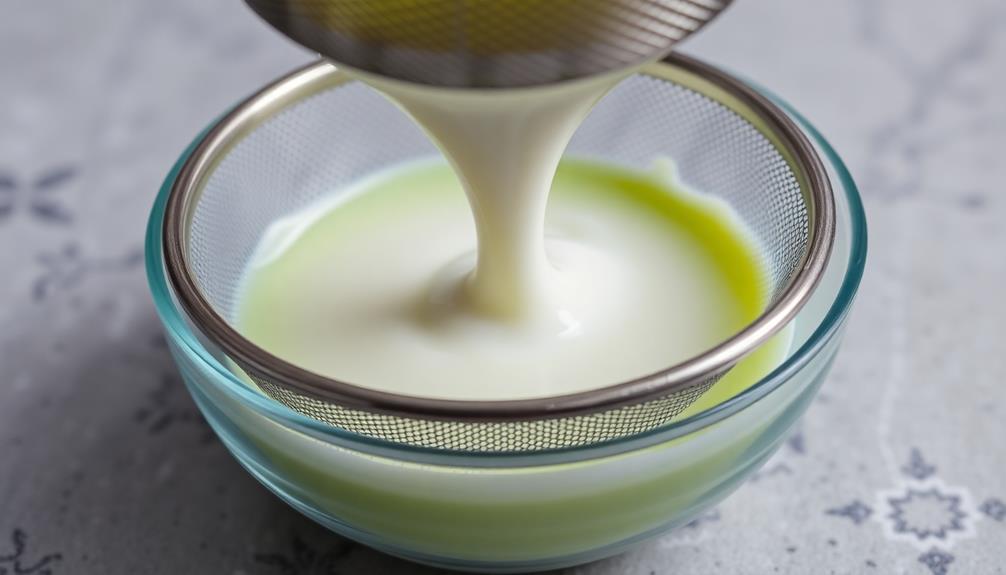
After preparing the coconut milk mixture, it's time to strain it. This step is crucial to ensure your cendol has a smooth, silky texture.
Grab a fine-mesh sieve or strainer and place it over a large bowl. Slowly pour the coconut milk mixture through the sieve, taking care to scrape any clumps or residue left behind. The strainer will catch any tiny bits of coconut meat, leaving you with a perfectly smooth and creamy coconut milk.
Once you've strained the entire mixture, you'll have a bowl full of rich, fragrant coconut milk ready for the next step. Give the strained coconut milk a gentle stir to ensure it's well incorporated.
Now you can move on to adding the green rice flour to create those delightful, chewy cendol noodles. Remember to work quickly, as the coconut milk will start to thicken as it cools.
With the coconut milk ready, you're one step closer to enjoying a refreshing and authentic cendol dessert.
Step 4. Mold the Coconut Milk Mixture
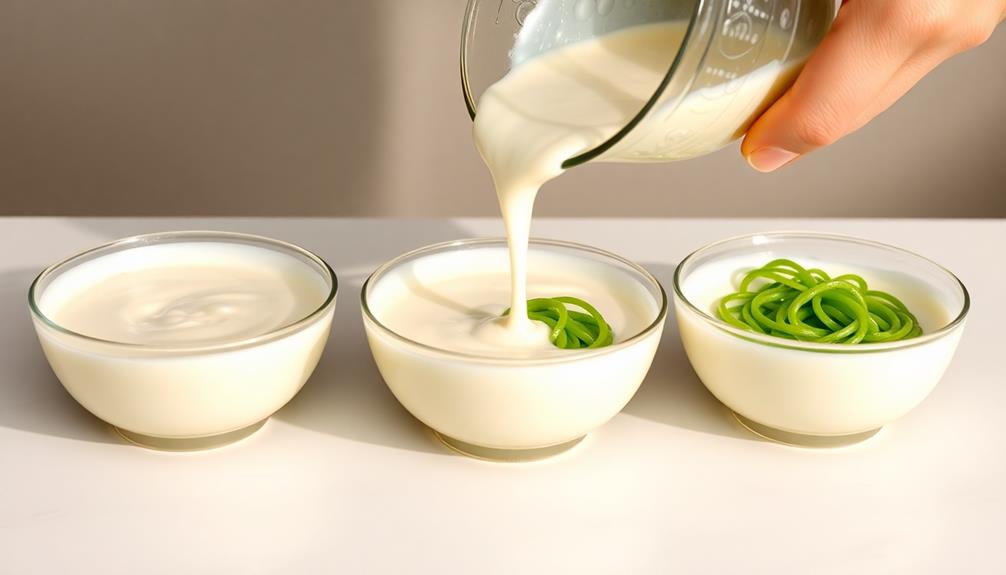
Now that you have the smooth and creamy coconut milk ready, let's mold the cendol noodles.
First, grab a small bowl and scoop the coconut milk mixture into it. Using a spoon, gently press the mixture through a cendol mold, which is a handheld device with small, round holes.
As the mixture passes through, it'll create thin, worm-like strands that resemble green noodles. These are your cendol!
Carefully transfer the noodles to a bowl of chilled water to set their shape.
Repeat this process, working in batches, until you've used up all the coconut milk mixture.
The cendol noodles should have a vibrant, emerald-green color and a soft, slippery texture.
Now they're ready to be combined with the other delightful components of the Es Cendol dessert.
Get excited – the best part is yet to come!
Step 5. Refrigerate to Set Cendol
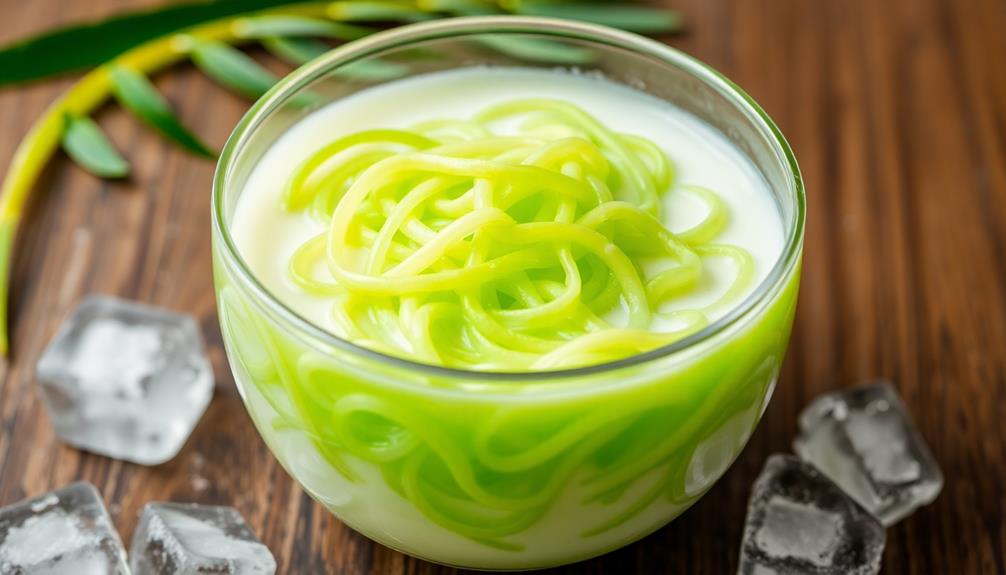
With your freshly molded cendol noodles, it's time to let them set in the chilled water. Carefully transfer the noodles to a shallow container and submerge them completely in cold water. You'll want to make sure the water covers the noodles by at least an inch.
Now, pop the container in the fridge and let it chill for about 30 minutes. This will allow the noodles to firm up and hold their shape.
While you wait, you can start preparing the other components of your Es Cendol dessert.
Once the 30 minutes are up, take a peek at the noodles. They should have a lovely, jelly-like texture. If they're still a bit soft, leave them in the fridge for another 10-15 minutes.
Final Thoughts
Cendol has undoubtedly left an indelible mark on the hearts and taste buds of many. This vibrant, colorful dessert has a way of capturing the imagination and bringing a smile to one's face.
Whether it's the striking green noodles, the rich, creamy coconut milk, or the playful blend of textures, there's something undeniably delightful about this Southeast Asian treat. One of the most iconic components of this dish is its delicious peanut sauce, which adds a satisfying kick of flavor to each bite. The secret to a perfect pecel recipe lies in the careful balance of sweet, spicy, and savory flavors. It’s no wonder that this dish has become a beloved staple in Southeast Asian cuisine.
As you've discovered, the process of making cendol may require a bit of effort, but the end result is well worth it.
The satisfying chew of the pandan-infused noodles, the cooling sensation of the coconut milk, and the subtle sweetness of the palm sugar – it's a symphony of flavors and sensations that will leave you craving more.
Frequently Asked Questions
Is Cendol Gluten-Free?
Yes, cendol is typically gluten-free. Since it's made from rice flour, coconut milk, and palm sugar, it doesn't contain any wheat or other gluten-containing ingredients. You can enjoy cendol without worrying about consuming gluten.
How Long Does Cendol Last in the Fridge?
Cendol typically lasts 3-4 days in the fridge when stored properly. Keep it covered and refrigerated to maintain its texture and flavor. However, it's best enjoyed fresh for the optimal experience.
Can I Use Regular Flour Instead of Rice Flour?
You can't use regular flour instead of rice flour. Regular flour won't give you the same chewy, gelatinous texture that rice flour provides. Stick with rice flour to get the authentic cendol experience.
Is Cendol Made With Natural Food Coloring?
No, cendol is typically made with natural food coloring, often from pandan leaves or other natural sources. You wouldn't want to use regular flour as it won't provide the same texture and flavor.
Can I Make Cendol Without Coconut Milk?
Yes, you can make cendol without coconut milk. Instead, you can use water, palm sugar, and other ingredients to create a delicious dessert that's just as flavorful and satisfying as the traditional version.
